Elliptical movement

Greetings to the entire steemit academic and scientific community.
Introduction
Humanity has been able to structure the knowledge related to the phenomenon of movement, and we could verify this with the previous articles, where we relate to the essential movements such as the circular and the parabolic, each one with its particular path or trajectory, and this trajectory represented by the geometric place of a determined figure such as the circumference and the parabola respectively.
This induces us to know some characteristics of the geometric figure that describes the elliptical movement, that is to say, the ellipse, since this figure plays a vital role in the analysis of this mobility, and in this way we arrive at another type of curvilinear movement studied from the vision of kinematics, which as is known studies this phenomenon independently of the type of force that causes it.
The field of science, historically, has been the result of the interrelation of three basic elements, where the first one is represented by the reality that surrounds us, that is to say, the whole set of so-called objective facts, as a second element we have experimentation, and as a third component the theory, which has been constructed or developed through the most precious of humanity's gifts, thought.
According to the above, we can say that the phenomenon of movement is immersed in our reality, analyzed experimentally and then structured theoretically, as we see in the circular and parabolic mobilities, and now we will do it in the elliptical movement.
When speaking of elliptical motion we must refer to a historical example which develops this important phenomenon as is the movement of our planets in the solar system, but also some types of artificial satellites need this type of movement to meet a certain objective.
But we can observe this mobility in very everyday activities in our lives, in the development of this article we will be linked to this type of elliptical movements particular and very useful for man in various areas of their existence, demonstrating that the phenomenon of movement will always be present among us, manifesting itself in different ways according to the type of route, geometric place or trajectory.
The Ellipse
Any of us have been able to observe some type of image or object related to the geometric figure of the ellipse, where this figure represents the geometric place originated by the mobility of a point in the plane, where we are two fixed points called focal points, and the sum of the lengths of a given point to these focuses is always constant, and this will not be greater than the length or distance between such focuses.
Therefore, it is important to know some elements present in this geometric figure as shown in figure 1 below.
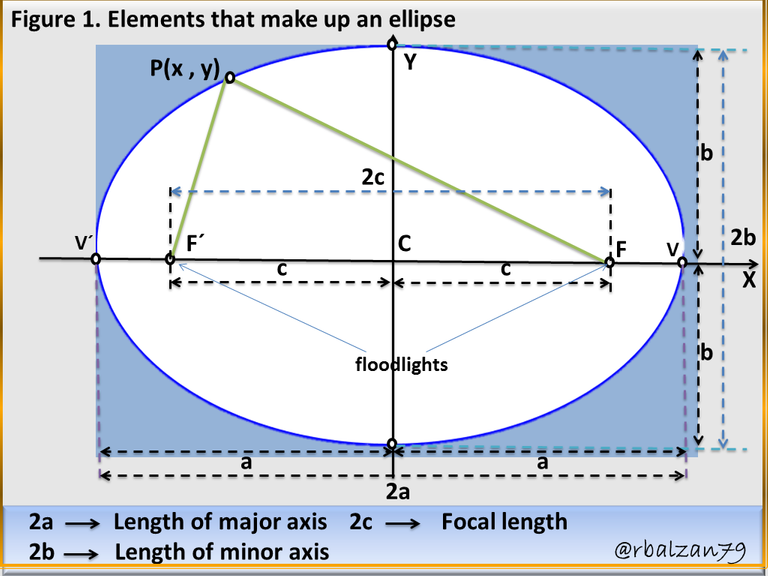
With the previous figure 1, we are related to the description of the trajectory of the elliptical movement, since the name of each mobility is related according to the geometric figure that describes its trajectory.
There is a very important element or characteristic to highlight in this figure, and the same is the eccentricity of the ellipse, this represents the degree of crushing of the closed curve, because if its value is equal to zero then we would be talking about a circumference instead of an ellipse, the eccentricity can be defined as the reason or the quotient c/a and is symbolized with the letter (e), represented by the following expression:

Elliptical movement
In a general way we can express that a certain particle, body or object (mobile), is moved following an elliptical movement, when in its trajectory it describes the geometric place of an ellipse, in summary words, that of a flattened circumference in two of its extremes, as we observe it in the description of this figure from the geometric point of view.
This elliptical phenomenon can be observed in the movement or orbital translation of different celestial bodies, such as the planets of our solar system, natural or artificial satellites, among many other bodies or objects that are either close to us as those of astronomical type that are at the top of our solar system, but all immersed in our wonderful universe, as we can see in Figure 2 below.
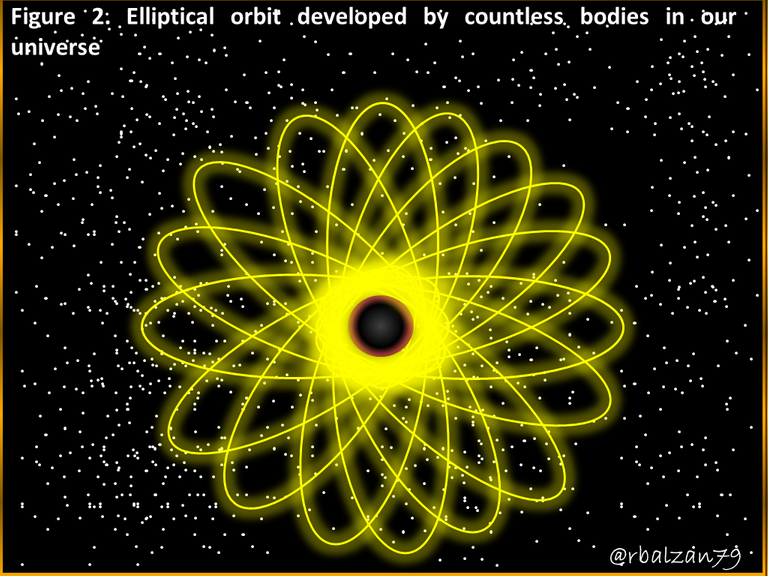
Movement of planets in the solar system (historical example)
When we speak of elliptical motion it is impossible not to mention the imposing motion of our planets, because each of the planets of our solar system maintain their orbit thanks to the centripetal force provided by the gravitational attraction that exists between the central star, the Sun, and each of these celestial bodies.
It is important to emphasize that we can express that the orbits of these planets could be considered of the circular type with some degree of eccentricity or flattening, therefore, the trajectory described by these planets represents the geometric place of an ellipse developing then to the elliptical movement.
We can also say that each of these planets orbit around the Sun, because the mass of this central star is much greater than that of these planets, which is why it is the center of mass for any particle or body of our solar system, for example, any star or planet orbit both around its center of mass, which in this case is common to them, the Sun.
The force with which the Sun attracts planets, particularly the earth, is represented by the following equation:
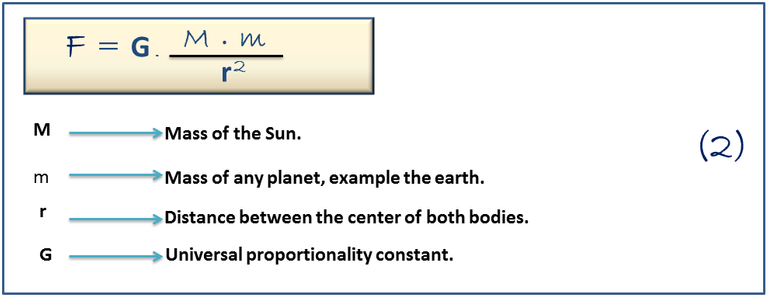
We can emphasize in this way that this force is responsible for the centripetal force that will maintain in elliptical orbit any planet of the solar system, as we can see in the following figure 3.
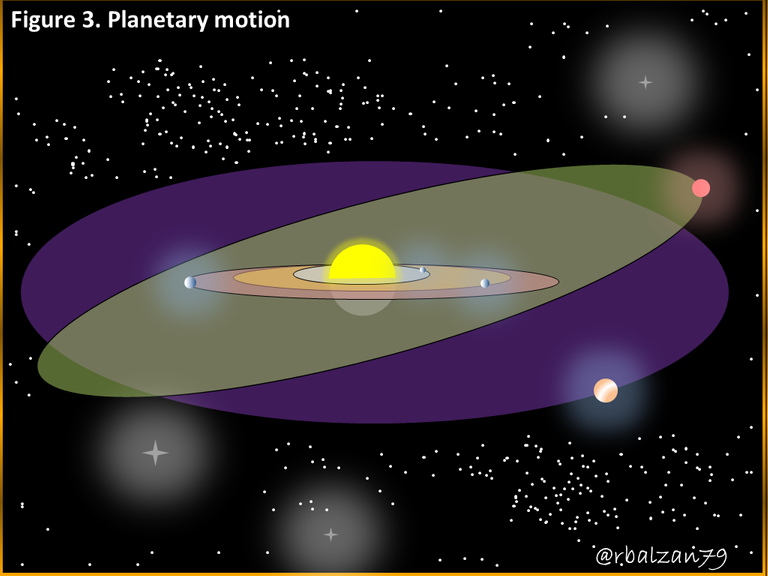
Movement of artificial satellites
We have already been able to verify that in our universe we find diverse examples of elliptical movements, therefore, it is necessary to emphasize that at terrestrial level we can find great variety of orbits according to its classification, these orbits are implemented for the launch of any type of artificial satellites, where we can find parameters universally used as height, handling, shape, among others, to categorize these orbits.Then, according to the mission intended for the satellite to launch is what will determine what type of orbit it will traverse or trace the same, Therefore, in general we can identify four types of missions:
1.- Scientists.
2.- Application.
3.- Communications.
4.- Navigation.
2.- Application.
3.- Communications.
4.- Navigation.
In this way we find several classifications for Earth orbits, but as our analysis is oriented towards elliptical motion we will focus on the classification according to the eccentricity of that orbit (elliptical), remembering that satellites may describe different trajectories such as that of a circle, parabola, ellipse and hyperbola.
Everything will depend on the speed with which they are launched, since if this speed is lower than the escape speed, the satellite will be in circular or elliptical orbit, the latter represents our case study, in conclusion, the eccentricity of the orbit will determine the type of trajectory to describe or traverse by some particle, body or object (in this case an artificial satellite).
It is important to bear in mind that an orbit represents a certain periodic trajectory followed by both natural and artificial satellites. This path is based on the three laws of Kepler and they are supported mathematically by the Law of Universal Gravitation and from the dynamic point of view by Newton's extraordinary second law of motion.
It is important to be able to relate to some parameters in this type of elliptical motion, so we have:
Orbital velocity
For a satellite the orbital velocity must be concrete or specific to allow it to be in orbit and to be able to balance the gravitational effect, as we know and have repeatedly expressed that a certain force of gravity exerted by any celestial body is reduced in inverse proportion to the square of the distance, therefore, when a satellite is in the highest, this force of gravitational attraction will be smaller and consequently its orbital velocity also.HEO Satellites
These types of HEO ("Highly Elliptical Orbit") satellites are the clearest example of these types of artificial satellites that describe the trajectory of an elliptical orbit, they have an apogee greater than 36.This allows them to provide better coverage at high altitude in those areas not reached by GEO ("Goestationary Earth orbit") satellites, as for the orbital period of these HEO satellites varies between 8 and 24 hours, then we will observe the trajectory of this type of satellite in Figure 4 below.
We found that the type of HEO system most used for communications is the satellite known as Molniya system, it is manufactured to provide coverage at high northern latitudes, for this type of orbit is also known as another type of system called Tundra.
Other types of elliptical movements
We also find elliptical movements of easy observation as is the case of the movements originated by those rings of colors that we know with the name of hula hula, which is made to turn around the waist and of this form it is observed to an ellipse, or the turn of an elliptical bicycle, of equal form the movement of a rope or rope on our heads originating this elliptical figure, as we observed in the following figure 5.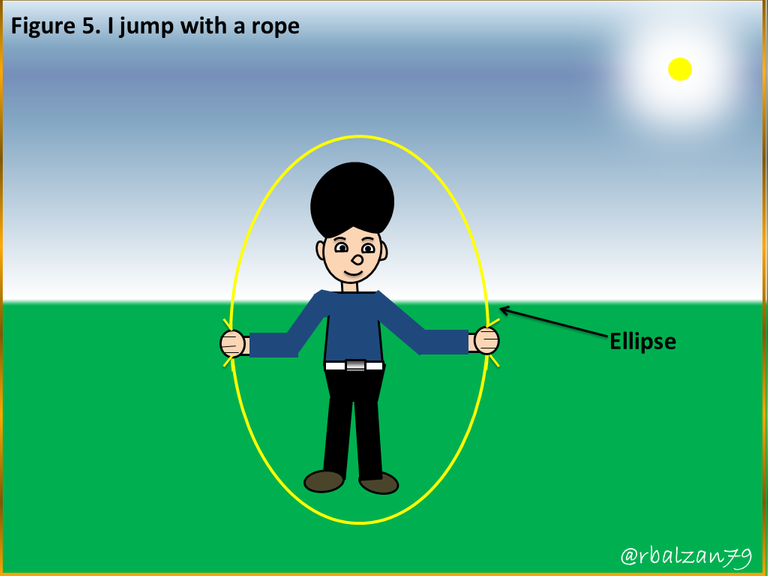
We also find objects with elliptical shape that are based on the geometric properties of this figure, taking into account its focuses as happens with an elliptical pool table, as we can see in the following figure 6.

Conclusion
When we refer to the phenomenon of movement we will find impressive applications that man through science has managed to transfer into our activities, our existence constantly claims some kind of mobility and our purpose in each of these articles is to look for any form of movement that is around us.
In this opportunity we analyze another curvilinear movement, the elliptical, which is a closed movement and, therefore with periodic characteristics, as we observe in each of the examples mentioned above, we could say that the movements analyzed so far represent fundamental mobilities or bases for any other type of movement that develops in our environment, this we will continue demonstrating in subsequent publications.
To be able to know our solar system has always been of great interest to humanity. This has been our great and historic point of reference, the planetary movement, since this knowledge has led us to take gigantic steps in the manufacture of systems with artificial elliptical movements, as we could see with satellites.
But the elliptical movement in the same way we find it in many more everyday activities for us as represented by the fact of jumping a rope, which on many occasions we use this activity to improve our physical condition or also to have a little fun, or clearly exercise with an elliptical bicycle, move the waist with a hula hula, move the loop of a rope over our heads, all this shows that the phenomenon of movement is an intrinsic part of our lives, and its elliptical version is not left out.
If we could observe from the top of our galaxy, we would notice that the elliptical movement is developed by the vast majority of the celestial bodies present in it, this makes it a movement with great applications in the search for our intellectual and social growth.
Until another opportunity my esteemed readers of steemit, especially the members of the great community #steemstem, for which I highly recommend to be part of this beautiful project, as it highlights the valuable work of academia and the scientific field.
Note: All images were created using the Paint, Power Point and animated gif applications with the PhotoScape application.
Bibliographic references
[1] Charles H. Lehmann. Analytic geometry.
[2] Lior M. Burko and Richard H. Price. Department of Physics, University of Utah, Salt Lake City.
[3] Snapper, E., Troyer, R.J. Metric Affine Geometry. Dover, New York, 1971.
[4] O. Montebruck, E. Gill. Satellite Orbits, Springer.
[5] Williams J. Astore, Robert B. Giffen, Wiley J. Larson, Understanding Space, second edition, 2004.
0
0
0.000
To listen to the audio version of this article click on the play image.

Brought to you by @tts. If you find it useful please consider upvoting this reply.
Hello,
Your post has been manually curated by a @stem.curate curator.
We are dedicated to supporting great content, like yours on the STEMGeeks tribe.
Please join us on discord.
Thanks for the support. Greetings.